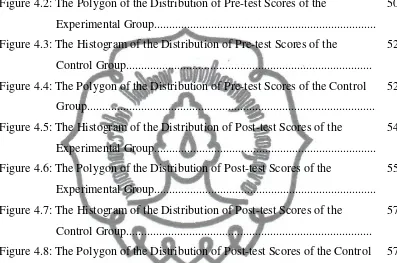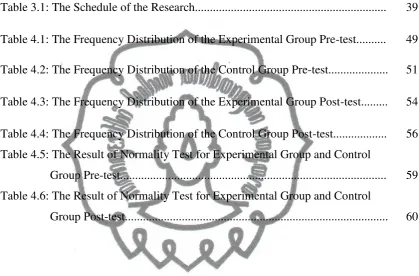commit to user
A COMPARATIVE STUDY BETWEEN LEARNING CELL AND DIRECT
INSTRUCTIONAL METHOD TO TEACH READING
(An Experimental Study on the Eighth Grade Students at SMP N 14
Surakarta in the Academic Year 2014/2015)
Submitted to the Faculty of Teacher Training and Education of Sebelas
Maret University to Fulfill One of the Requirements for Getting the
Undergraduate Degree of Education in English
By:
PURNAWATI ZUHRO
K2210064
ENGLISH EDUCATION DEPARTMENT
TEACHER TRAINING AND EDUCATION FACULTY
SEBELAS MARET UNIVERSITY
SURAKARTA
commit to user
commit to user
commit to user
commit to user
v ABSTRACT
Purnawati Zuhro. K2210064. A Comparative Study between Learning Cell
and Direct Instructional Method to Teach Reading (An Experimental Study on the Eighth Grade Students at SMP N 14 Surakarta in the Academic Year 2014/2015). A thesis. Surakarta : Faculty of Teacher Training and Education of Sebelas Maret University, 2014.
The aim of this research is to find out: (1) whether there is a significant difference in the achievement of reading skill between the students taught using learning cell and those taught using direct instructional method; and (2) whether learning cell is more effective to teach reading than direct instructional method.
Related to the objectives of the research, the method used in this research was quantitative through experimental approach in order to analyze the collected data. The research was conducted in August-September 2014. The population of this research was the eighth grade students of SMP N 14 Surakarta in the academic year of 2014/2015. From the whole population, two classes were taken as the sample where each class consisted of 33 students. The sample were class VIII A as the experimental group and VIII B as the control group. The sampling technique used was cluster random sampling. The data were collected by conducting a test and were analyzed by using t-test formula.
commit to user
vi MOTTO
“Innallahha Ma’as Sabirin”
(Al Baqarah 153)
“Miracle is another name of hardwork”
(Korean Drama)
“Lakukan
pekerjaanmu dengan penuh bakti
,
layaknya sebuah
panggilan bukan beban
,
maka kau tak akan pernah merasa
bosan
”
commit to user
vii
DEDICATION
This thesis is whole-heartedly dedicated to those
who support me to keep struggling to get better
future:
My beloved parents, Ibu and Bapak (Alm)
My beloved older sisters and brothers
My cute nephews and nieces
My best (crazy) friends, SBI 22 ’10, “
Y
ou’re
the treasure of
my college life, guys!”
My fellow Pondok Sakura friends; Vika,
Wijeng, Dhea, Bhrehita, Mbak Yeti, Nindy,
Asri, Irma, Amel, Indah
, “Thanks for always
cheering and supporting me!”
All the people who have helped and
commit to user
This thesis will never exist without the permission and approval from Prof.
Dr. H. M. Furqon Hidayatullah, M.Pd, the Dean of the Teacher Training and
Education Faculty, Dr. Muh. Rohmadi, S.S, M.Hum, the Head of the Art and
Language Education, and Teguh Sarosa, S.S, M.Hum, the Head of English
Education Department of Teacher Training and Education Faculty. Her sincere
gratitude is also extended to all lecturers in English Department UNS, for all the
knowledge and experiences shared.
Her gratitude also goes to Dr. Ratna Purwaningtyastuti, M.Pd, the
Headmaster of SMP N 14 Surakarta, for the permission to conduct the research in
SMP N 14 Surakarta, Tri Keksih, S.Pd, the English teacher of SMP N 14
Surakarta, for being the best supporter during the research, and of course the
students of VIII G, VIII A, and VIII B SMP N 14 Surakarta in the academic year
2014/2015, for the participation.
The writer’s last special gratitude is for her family for their love, prayer, supports, caring, and helps, her friends in English Education Department and in
Pondok Sakura, for always caring and cheering her.
Needless to say, this thesis is still far from being perfect. The writer will
accept gratefully every comment and suggestion. Hopefully, this thesis will give
benefit for everyone who concerns with the same research.
Surakarta, December 2014
commit to user
ix
TABLE OF CONTENTS
TITLE……… i
PRONOUNCEMENT ……….. ii
THE APPROVAL OF THE CONSULTANTS………... iii
THE APPROVAL OF THE EXAMINERS...……… iv
ABSTRACT...………... v
MOTTO..………... vi
DEDICATION……….. vii
ACKNOWLEDGEMENT……….... viii
TABLE OF CONTENTS……….. ix
LIST OF APPENDICES………... xiii
LIST OF FIGURES………... xv
commit to user
x
3. Principles of Teaching Reading... 13
4. Purpose of Reading... 15
5. Strategies in Reading... 16
6. Models of Reading... 18
B. Review of Teaching Reading to Junior High School…... 19
1. Teaching Reading... 20
2. Teaching Reading to Junior High School... 21
C. Review of Learning Cell………... 22
1. Definition of Learning Cell... 22
2. Teaching Steps of Learning Cell... 24
3. The Strengths of Learning Cell... 25
4. The Weaknesses of Learning Cell... 27
D. Review of Direct Instructional Method……….... 27
1. Definition of Direct Instructional Method... 27
2. Teaching Steps of Direct Instructional Method... 28
3. The Strenghts of Direct Instructional Method... 33
4. The Weaknesses of Direct Instructional Method.... 34
commit to user
1. The Instrument of Collecting the Data... 41
2. Validity and Reliability... 41
a. Validity... 41
b. Reliability... 42
E. The Technique of Analyzing the Data………. 43
1. Descriptive Statistics... 43
2. Normality Test... 43
3. Homogeneity Test... 44
4. T-test... 45
F. Statistical Hypothesis………... 46
CHAPTER IV THE RESULT OF THE STUDY……….... 47
A. The Description of the Data………... 47
1. Pre-test Score... 47
a. The Experimental Group... 47
b. The Control Group... 50
2. Post-test Score... 53
a. The Experimental Group... 53
b. The Control Group... 55
B. Prerequisite Tests………... 58
commit to user
xii
a. Similarity of Two Classes... 58
b. Result of Normality Test... 58
c. Result of Homogeneity Test... 59
2. Post-test Score... 60
a. Result of Normality Test... 60
b. Result of Homogeneity Test... 61
C. Hypothesis Testing………... 61
1. The First Hypothesis... 61
2. The Second Hypothesis... 62
D. Discussion………... 63
CHAPTER V CONCLUSION, IMPLICATION, AND SUGGESTION... 66
A. Conclusion……….... 66
B. Implication………... 66
C. Suggestion……….... 67
BIBLIOGRAPHY………. 69
commit to user
xiii
LIST OF APPENDICES
Appendix 1: Research Schedule………. 73
Appendix 2: Lesson Plan for Experimental Class ... 75
Appendix 3: Lesson Plan for Control Class ... 114
Appendix 4: Blue Print of Reading Test Instrument before Try-out………... 152
Appendix 5: Reading Test Instrument before Try-out... 153
Appendix 6: The Validity of Reading Try-out………... 164
Appendix 7: The Reliability of Reading Try-out Valid Items……… 174
Appendix 8: Blue Print of Reading Test Instrument after Try-out……… 180
Appendix 9: Reading Test Instrument after Try-out... 181
Appendix 10: List of Students’ Name……… 189
Appendix 11: The Score of Pre-test... 191
Appendix 12: The Score of Post-test... 192
Appendix 13: Students Answer Sheet of Experimental Group... 193
Appendix 14: Students Answer Sheet of Control Group... 197
Appendix 15: Frequency Distribution... 201
Appendix 16: Normality Test of Pre-test of the Experimental Group... 205
Appendix 17: Normality Test of Pre-test of the Control Group... 207
Appendix 18: Normality Test of Post-test of the Experimental Group... 209
Appendix 19: Normality Test of Post-test of the Control Group... 211
Appendix 20: Homogeneity Test of Pre-test... 213
Appendix 21: Homogeneity Test of Post-test... 216
commit to user
xiv
the Control Group... 219
Appendix 23: T-test Computation of Post-test of the Experimental Group and the Control Group... 221
Appendix 24: Table of r Product Moment... 223
Appendix 25: Table of the Standard Normal Distribution... 224
Appendix 26: Table of Critical Value of Lilliefors Test... 225
Appendix 27: Table of Chi-Square Distribution... 226
Appendix 28: Table of t Distribution... 227
Appendix 29: Photographs... 229
commit to user
xv
LIST OF FIGURES
Figure 4.1: The Histogram of the Distribution of Pre-test Scores of the
Experimental Group... 49
Figure 4.2: The Polygon of the Distribution of Pre-test Scores of the
Experimental Group... 50
Figure 4.3: The Histogram of the Distribution of Pre-test Scores of the
Control Group... 52
Figure 4.4: The Polygon of the Distribution of Pre-test Scores of the Control
Group... 52
Figure 4.5: The Histogram of the Distribution of Post-test Scores of the
Experimental Group... 54
Figure 4.6: The Polygon of the Distribution of Post-test Scores of the
Experimental Group... 55
Figure 4.7: The Histogram of the Distribution of Post-test Scores of the
Control Group... 57
Figure 4.8: The Polygon of the Distribution of Post-test Scores of the Control
commit to user
xvi
LIST OF TABLES
Table 2.1: Reading Strategies by Brewster, Ellis, and Girard... 18
Table 3.1: The Schedule of the Research... 39
Table 4.1: The Frequency Distribution of the Experimental Group Pre-test... 49
Table 4.2: The Frequency Distribution of the Control Group Pre-test... 51
Table 4.3: The Frequency Distribution of the Experimental Group Post-test... 54
Table 4.4: The Frequency Distribution of the Control Group Post-test... 56
Table 4.5: The Result of Normality Test for Experimental Group and Control Group Pre-test... 59

